Wireless bottle cap monitor may improve eye drop adherence in patients with glaucoma
Key takeaways:
- Being monitored improved eye drop adherence in patients with glaucoma.
- Additional studies of patients with low baseline adherence are needed to determine the effectiveness of reminders with bottle cap monitors.
An eye drop bottle cap monitor measured and improved adherence in patients with glaucoma, with 80% of users experiencing at least a 90% adherence rate, according to data published in Journal of Glaucoma.
“Glaucoma patients have high adherence when they are being monitored, and future studies with research subjects screened for poor adherence may further determine the benefit of electronic monitoring of adherence with and without electronic reminders,” Robert M. Kinast, MD, a glaucoma surgeon and associate director of the glaucoma fellowship at Legacy Devers Eye Institute in Portland, Oregon, and colleagues wrote.

In this study, 53 participants with glaucoma at the Devers Eye Institute were enrolled between December 2020 and May 2021 to determine whether a bottle cap monitor on eye drops could measure and improve adherence.
In the first stage of the trial, researchers measured baseline adherence of nightly latanoprost eye drop usage over 25 days using the Devers Drop Device (D3), a wireless smart cap monitor that attaches to an eye drop bottle cap and tracks cap movement. They reported the baseline mean adherence rate was 90%, with 80% of participants having an adherence rate greater than 90%, and 86% having an adherence rate greater than 80%. Participants with less than 90% adherence could continue into an additional 25-day period.
In the second stage of the study, participants were randomized into groups that received audio, visual or text reminders, or no reminder. If participants in the reminder group failed to use their drop at their scheduled dosing time, they would receive audio and visual alerts on the D3 and a text message on their phone. The alerts continued every 10 minutes for 30 minutes or until the bottle cap was removed.
Of those who completed the second stage of the study, two from the reminder group improved their adherence by 4% (from 85% to 89%) and 46% (from 54% to 100%) compared with the first stage. One participant in the no reminder group improved their adherence by 6% (from 68% to 74%).
“The D3 remained successfully attached to the eye drop bottle cap and measured adherence in all 50 subjects,” Kinast and colleagues wrote. “Adherence data was successfully stored on the D3 and usually communicated through a central server. We will need to select a higher proportion of patients with poor adherence to test whether alerts would improve adherence.”

